
The American Game is an American breed of game fowl, chickens bred specifically for cockfighting. It has many color varieties, and may also be kept for ornament.

The Silkie is a Chinese breed of chicken named for its atypically fluffy plumage, which is said to feel like silk and satin. The breed has several other unusual qualities, such as black skin and bones, blue earlobes, and five toes on each foot, whereas most chickens have only four. They are often exhibited in poultry shows, and also appear in various colors. In addition to their distinctive physical characteristics, Silkies are well known for their calm and friendly temperament. It is among the most docile of poultry. Hens are also exceptionally broody, and care for young well. Although they are fair layers themselves, laying only about three eggs a week, they are commonly used to hatch eggs from other breeds and bird species due to their broody nature. Silkie chickens have been bred to have a wide variety of colors which include but are not limited to: Black, Blue, Buff, Partridge, Splash, White, Lavender, Paint and Porcelain.

The Orpington is a British breed of chicken. It was bred in the late nineteenth century by William Cook of Orpington, at that time in Kent in south-east England. It was intended to be a dual-purpose breed, to be reared both for eggs and for meat, but soon became exclusively a show bird. The Australorp of Australia derives from it.

The Cochin is a breed of large domestic chicken. It derives from large feather-legged chickens brought from China to Europe and North America in the 1840s and 1850s. It is reared principally for exhibition. It was formerly known as Cochin-China.
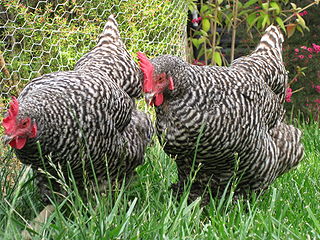
The Plymouth Rock is an American breed of domestic chicken. It was first seen in Massachusetts in the nineteenth century and for much of the early twentieth century was the most widely kept chicken breed in the United States. It is a dual-purpose bird, raised both for its meat and for its brown eggs. It is resistant to cold, easy to manage, and a good sitter.
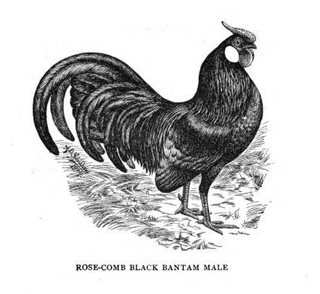
The Rosecomb is a breed of chicken named for its distinctive comb. Rosecombs are bantam chickens, and are among those known as true bantams, meaning they are not a miniaturised version of a large fowl. Rosecombs are one of the oldest and most popular bantam breeds in showing, and thus have numerous variations within the breed. An ornamental chicken, they are poor egg layers and not suited for meat production.

The Ameraucana is an American breed of domestic chicken. It was developed in the United States in the 1970s, and derives from Araucana chickens brought from Chile. It was bred to retain the blue-egg gene but eliminate the lethal alleles of the parent breed. There are both standard-sized and bantam versions.

The Sebright is a British breed of bantam chicken. It is a true bantam – a miniature bird with no corresponding large version – and is one of the oldest recorded British bantam breeds. It is named after Sir John Saunders Sebright, who created it as an ornamental breed by selective breeding in the early nineteenth century.

The Buckeye is an American breed of chicken. It was created in Ohio in the late nineteenth century by Nettie Metcalf. The color of its plumage was intended to resemble the color of the seeds of Aesculus glabra, the Ohio Buckeye plant for which the state is called the 'Buckeye State'.
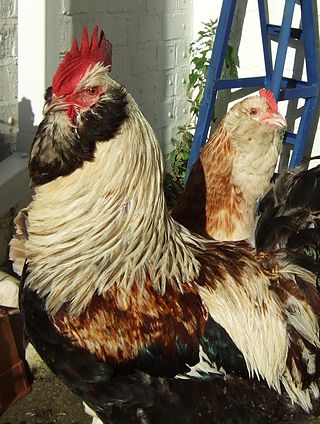
The Faverolles is a French breed of chicken. The breed was developed in the 1860s in north-central France, in the vicinity of the villages of Houdan and Faverolles. The breed was given the name of the latter village and the singular is thus also Faverolles, not Faverolle. The final "s" is silent in French.

The Dutch Bantam is a breed of bantam chicken originating in the Netherlands. It is a true bantam, a naturally small bird with no related large fowl from which it was miniaturized. It is kept mainly for exhibition, and has been bred in many color varieties; it is a good layer of small eggs.
The Marsh Daisy is a rare breed of chicken originating in Lancashire, England. Its name may be related to its origin in a marsh-like area, or that its large rose comb resembles the flower of the Marsh Daisy.

The Rhode Island White is a breed of chicken originating in the U.S. state of Rhode Island. Despite their very similar names and shared place of origin, the Rhode Island White is a distinct breed from the Rhode Island Red. However, Rhode Island Reds and Whites can be bred together to create Red Sex-Link hybrid chickens, such as the ISA Brown. In Australia, the Rhode Island White is regarded as a color variety of the Rhode Island breed according to the Australian Poultry Standards.

The Java is a breed of chicken originating in the United States. Despite the breed's name, a reference to the island of Java, it was developed in the U.S. from chickens of unknown Asian extraction. It is one of the oldest American chickens, forming the basis for many other breeds, but is critically endangered today. Javas are large birds with a sturdy appearance. They are hardy, and are well-suited for both meat and egg production, especially by small-scale farms, homesteads, and backyard keepers.
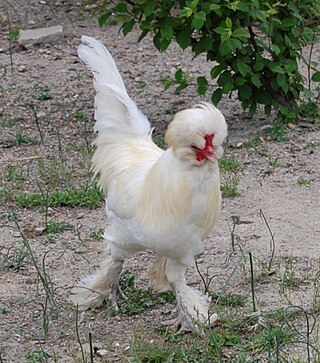
The Sultan is a Turkish breed of crested chicken. The name derives from the original Turkish language name of Sarai-Tavuk, which translates as "fowls of the palace". They have always been primarily ornamental, having been kept in the gardens of Ottoman sultanate. In the West they are bred for competitive showing as part of poultry fancy, and are generally a rare sight.
The Iowa Blue is a breed of chicken that originated near Decorah, Iowa, in the early twentieth century. Despite its name, the breed is not actually blue according to poultry standards. It is an exceedingly rare fowl, and is not recognized for showing by the American Poultry Association. They are a dual-purpose breed laying brown eggs and known to be good foragers.
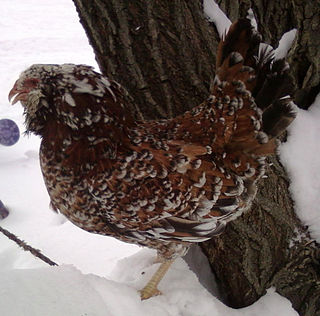
The Orloff is a breed of chicken named after Alexei Grigoryevich Orlov, a Russian Count. Reflecting this origin, it is sometimes called the Russian Orloff or simply Russian.
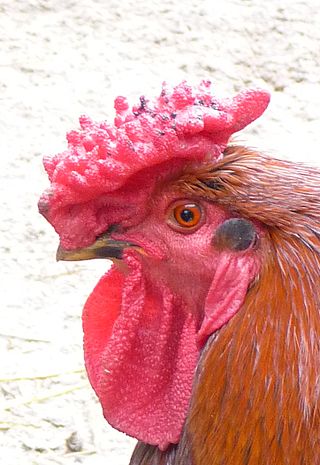
The Derbyshire Redcap is a breed of chicken originating in the English county of Derbyshire. The name "Redcap" derives from the breed's unusually large Rose-type comb. British breed standards dictate a length of more than 7 centimetres (3 inches) of length for a Redcap comb. It is covered in small, fleshy points, and has a distinct spike pointing backwards called a "leader". Combs, wattles and earlobes are all ideally bright red.

The Kraienkopp or Twents Hoen is a breed of chicken originating on the border region between Germany and the Netherlands. The latter of the two names is the Dutch language version, while the former is German.


















